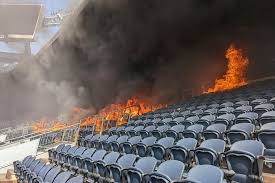
Leicester City’s King Power Stadium Demolished: End of an Era for the Foxes

Leicester City Football Club’s iconic King
Power Stadium, a symbol of both triumph and tradition, has officially been
demolished. The stadium, which witnessed the Foxes’ meteoric rise from a
modest club to Premier League champions in 2016, has now been
reduced to rubble, marking the end of a significant chapter in the club’s history.
Opened in 2002, the King Power Stadium
replaced Leicester’s historic Filbert Street ground, providing a modern home
for the club and its fans. Originally named the Walkers Stadium, it was
renamed King Power Stadium in 2011 after the Thai duty-free company took
over ownership of the club.With a seating capacity of just over
32,000, the stadium served as a fortress for the team for more than two decades.
It became famous worldwide when Leicester, against all odds, claimed the
Premier League title in 2016. Under manager Claudio Ranieri, the team
produced one of the greatest underdog stories in sporting history. The stadium
became a pilgrimage site for football fans who admired the club’s fairytale victory.
The decision to demolish the King Power Stadium did not come lightly. While the
stadium served the club and its fans well, increasing demand for capacity and
improved facilities led the club’s owners to consider its future. Leicester’s
continued ambitions, both on and off the pitch, demanded a state-of-the-art
stadium that could accommodate more fans and generate greater revenue.
In recent years, many Premier League clubs have either expanded or built new
stadiums to keep up with growing fan bases and the commercial demands of
modern football. Leicester, with its plans to remain competitive at the highest
levels, followed suit. The King Power Stadium, despite its emotional
significance, was seen as insufficient to meet the future needs of the club.
For Leicester City fans, the demolition of the King Power Stadium represents more
than just the loss of a building—it is the closing of a venue that bore witness to
unforgettable memories. Thousands of supporters gathered in the final days
before demolition, taking one last look at the stadium that had been a home to
moments of pure joy, including the lifting of the Premier League trophy.
The stadium also holds a deep connection to the memory of the club’s
late owner, Vichai Srivaddhanaprabha, who tragically died in a helicopter crash
outside the ground in 2018. Under Vichai’s ownership, the club enjoyed
unprecedented success, and the stadium became synonymous with his legacy.
The demolition clears the way for the
construction of a new, world-class stadium that will cater to more fans and
include cutting-edge facilities. While details of the new stadium project are
still being finalized, early plans suggest a capacity increase to around 40,000 seats,
luxury hospitality areas, retail spaces, and possibly even a hotel. The new
development aims to not only strengthen Leicester’s status in English football but
also provide a boost to the local economy.
The Foxes will play their home games at a temporary venue while construction of
the new stadium takes place. The club has reassured fans that the new ground
will incorporate elements of the old stadium to preserve its legacy, and
special tributes to the late Vichai will be included in the design.
While the demolition of the King Power
Stadium marks the end of an era, it also signals a bright future for Leicester City
Football Club. The new stadium will be a symbol of the club’s ambitions to
maintain its place at the top tier of English football. For now, fans bid
farewell to the iconic venue, but they also look forward to creating new
memories in a new home that will befit the club’s growing stature.
Leicester City may have torn down a stadium, but the spirit of the Foxes
remains unshaken, ready to rise again in a new arena.
For more related article>>>>>>>>https://kvibezsport.co.uk/?p=1428&preview=true
Leave a Reply